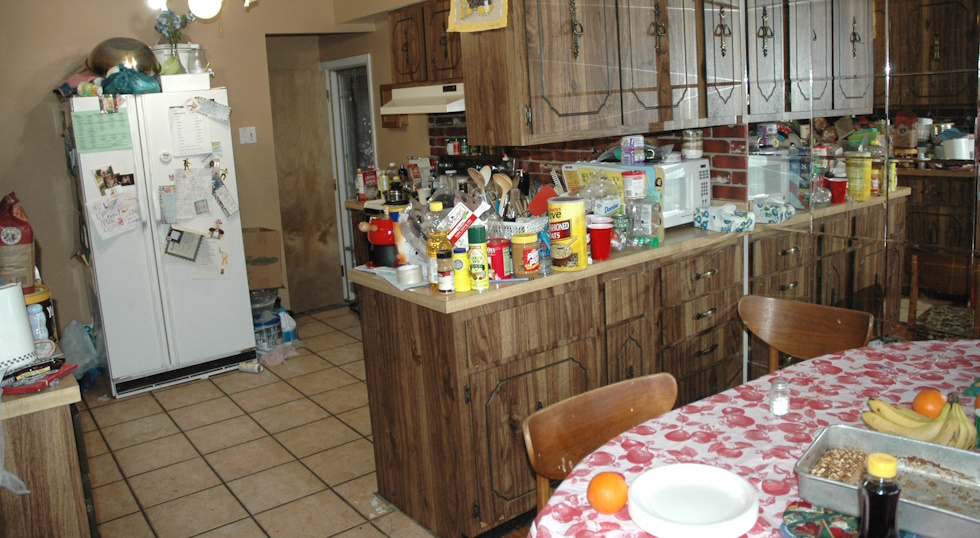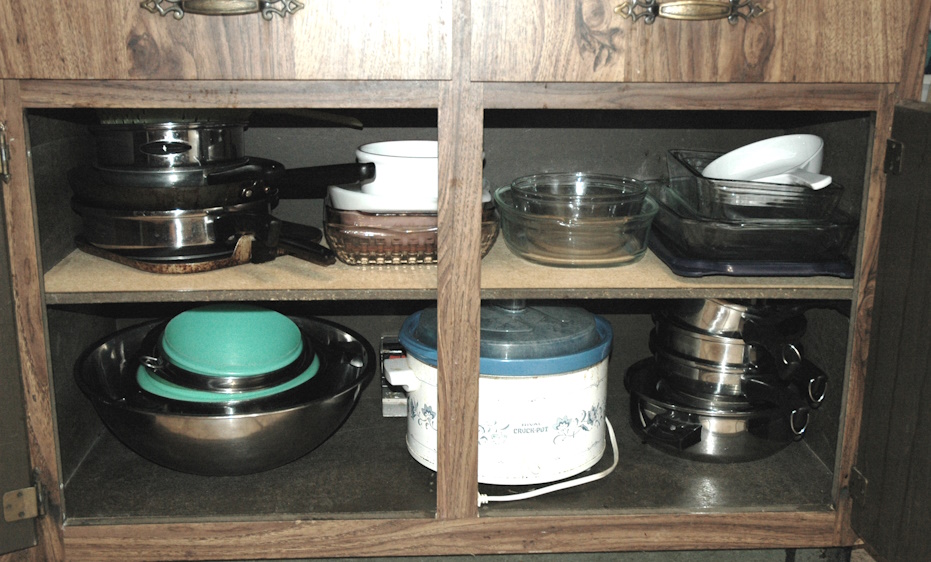Surveying my kitchen, in the early morning, the cool air is tingly and invigorating. The sunlight glints off the ceramic crock holding my cooking utensils. I recall several years back helping my sister-in-law, Maria, declutter your kitchen when her drawers were crammed with gadgets she never used. The countertops were literally buried under piles of things, and the appliances gathered dust. Her pantry had become more of an archaeological dig than food storage. The journey of her kitchen transformation is something that everyone can attain. She found new hope with my helpful homesteading hand.
Today, I’ll share with you the wisdom gained from that intensive decluttering process—both the practical steps and the deeper insights that have helped me maintain a functional, joy-filled kitchen space. Whether you’re working with a sprawling farmhouse kitchen or a compact urban apartment, these principles will assist you in creating a space that fits your style.

Starting With Heart: The Foundation to Declutter Your Kitchen
Before you pull out a drawer or empty a single cabinet, take a moment to connect with your kitchen’s purpose. In traditional homesteading, the kitchen wasn’t just for cooking—it was command central for food preservation, herbal medicine making, seed starting, and countless other essential tasks. The modern kitchen still plays an important part in daily life, which means the items in it have important roles that need to be carefully evaluated.
As a child, I remember watching my mother work. Her movements were like a well-choreographed dance, each tool exactly where her hands expected to find it. The wooden spoons worn smooth over decades, the seasoned cast iron, the sharp knives—each tool had its purpose in her daily rhythm.
When I first visited Maria’s home, she thought more tools meant more possibilities. She filled her kitchen with gadgets that promised to make her life easier, or an amazing price tag that was too good to pass up. Every specialized tool seemed to catch her eye. As I visited over the years, I discovered her home ran out of room. Closets brimming to overflowing with things, and still she seemed to need things or find one more bargain. Maria had decided to move closer to family, but she could not put the house up for sale looking like it had been raided. I eagerly agreed to help one long weekend to get her kitchen and a few other spaces under control.
Declutter Your Kitchen: The Great Reset
Now comes the part that I’m sure caused Maria to catch her breath—emptying every space. Yes, everything! I learned this technique from my mother, who would empty her entire kitchen every spring, giving each item careful consideration before it could earn its way back into this coveted room.
Choose a time when you have at least a full day, ideally a weekend. Before starting, arrange a sorting area (I use dining table and floor), gather boxes for “keep,” “donate,” and “trash” categories, plus cleaning supplies and clear containers. In Maria’s cluttered kitchen, we cleared the table first to create a workstation. Keep a notepad for inventory, and consider involving children to teach them about intentional living.
As you remove items, group them by category: cooking tools, baking supplies, food storage, preservation equipment, and so on. This gives you a clear picture of what you actually own. In Maria’s kitchen we discovered a hidden drawer at the bottom of her oven! She did not even know there were items in it, let alone extra storage space.
The process of emptying her kitchen revealed stories I hadn’t expected.She placed her children’s artwork in a drawer. She didn’t know she had multiple toasters. I got lost in the piles, and a store sold one at an irresistible price.Someone washed clothing and placed it with kitchen towels instead of in the bedroom.
My mother’s seasonal emptying ritual was about renewal and reconnection. Following her practice, I’ve learned that fewer tools foster greater creativity and confidence.

Making Peace with Letting Go
Here’s where many of us struggle: letting go of items that are no longer necessary. That expensive juicer you used twice, the pasta maker that seemed essential during the sourdough craze, the mismatched storage containers that multiply like rabbits in the night. Remember: every item you keep requires energy—to store, to clean, and to work around.
I remember standing in Maria’s kitchen; she was holding a pot with a broken handle. It was hard for her to let it go. The weight of it in her hands was more than just physical—it carried memories of oatmeal breakfasts before school and of hot chocolate after the children came home from a cold walk in the winter. She had many other pots that met her needs perfectly. Keeping her old one was honoring a memory, not serving a purpose.
As you hold each item, pause to reflect deeply on its place in your kitchen. Consider when you last pulled it from its shelf and put it to use. Think about whether it truly supports your current homesteading practices or if it’s a relic of an abandoned cooking phase. Ask yourself honestly: if this item broke tomorrow, would you feel compelled to replace it? Perhaps you already own something else that serves the same purpose, making this piece redundant. Most importantly, notice how you feel when you use it—does it bring a sense of joy and purpose to your cooking practice, or does it inspire feelings of guilt or obligation? Perhaps you cringe at the thought of cleaning it.
My rule: if I haven’t used something in a full cycle of seasons, it probably doesn’t belong in my kitchen. Specialized preservation equipment and large stock pots used seasonally are stored elsewhere. The water bath canner, jars, roasting pans, and stock pots are accessible and easily brought to the kitchen when needed.
Creating Functional Zones When You Declutter Your Kitchen
Now comes the rewarding part—bringing back only what truly belongs. Think in terms of work zones, just like our homesteading ancestors did. Their kitchens had clear areas for hearth cooking, preservation, root storage, and daily meal prep. In Maria’s kitchen, this naturally evolved into distinct, purposeful spaces that supported each aspect of her busy life.
I created one section of her kitchen counter to do all her baking prep: cakes, desserts, etc. We stocked this area with items used specifically for baking: flour, salt, sugar, measuring cups and spoons, spatulas, and glass bakeware. Near the stove, I created a daily breakfast zone and a cooking area that both she and her children could easily utilize. The breakfast center contained the toaster and microwave, while the cupboards held cold cereal, plastic plates, bowls, and cups. We moved the spices to the side of the stove most often used for cooking and stocked the shelves with essential pots, pans, and tools, making meal preparation flow smoothly.
How Zone Systems Maximize Space
Other ideas are a preservation station dedicated to housing canning supplies, a dehydrator, and various fermenting vessels, and all the equipment needed for putting up the harvest. What about a peaceful tea and herb station to keep dried herbs, tea implements, and honey close at hand? Food storage areas stay organized by type and season, making meal planning and preservation projects more intuitive. The key is keeping like items together and storing them where you actually use them.
This zone system transformed not just Maria’s kitchen but my entire approach to kitchen organization in general. Each area became a dedicated workspace that supported specific tasks while flowing naturally into the next. The prepping station, for example, sits close to a sink for easy access to water and near a window that provides natural light and ventilation.
I discovered that proper zoning creates more space in the kitchen, not less. When everything has its place and purpose, you find you need fewer items overall. My mother used to say, “A well-organized kitchen expands to meet your needs,” and I’ve found this to be profoundly true. Even in the height of canning season, when every surface seems spoken for, having clear zones means I can work efficiently without feeling cramped.

The Art of Maintenance
Maintaining a clutter-free kitchen isn’t about perfection—it’s about rhythm. Just as you develop an eye for when plants need water or when compost needs turning, you’ll develop a sense for when your kitchen needs attention. Each evening, I take time to reset all surfaces, returning items to their proper homes and wiping down counters. As the month turns, I spend an afternoon checking pantry inventory, rotating stored foods, and noting what needs to be replenished. The seasons guide my deeper cleaning—each quarter brings a thorough reset of the kitchen zones, while once a year, I perform a full kitchen review, questioning each item’s place.
Remember: a working kitchen won’t look perfect. There will be days when every surface is covered processing tomatoes or drying herbs. That’s not clutter—that’s life. The goal is having the space and organization to support these essential tasks.

Building Community Through Sharing
As you declutter, consider how your excess might benefit others. That extra set of canning jars might help a neighbor start their preservation journey. The bread machine you never use could inspire someone else’s baking adventures. Our homesteading ancestors understood that community resilience depends on sharing resources and knowledge.
Last spring, while sorting through my excess canning supplies, I discovered I had accumulated many extra jars, and I did not need them all. Instead of continuing to store for “just in case,” I posted them on Facebook and Craigslist internet pages. Within days, I met Cathy, an older woman who had so many tips on canning and butchering chickens that I was taking notes! Those extra jars found a new home, and I gained a preservation partner.
Connect with local buy-nothing groups, homesteading circles, or community gardens. Your cleared space can become someone else’s fresh start. And who knows? The connections you make might lead to skill-sharing, seed exchanges, or collaborative preservation days.
The beauty of this sharing extends beyond physical items. Each tool carries with it stories and wisdom that deserve to be passed along. When I gave my spare fermenting crock to a family, I also shared my mother’s tips for perfect sauerkraut and the lessons learned from my own early fermentation experiments. This exchange of knowledge keeps traditional skills alive while building stronger community bonds.
Growing Forward
As I sit here now, watching the morning light play across my organized shelves, I’m grateful for the lessons of organization I have learned and grateful for the opportunity to pass along the wisdom I have gained. A decluttered kitchen isn’t just about clear countertops—it’s about creating space for the life you want to live. It’s about honoring the wisdom of traditional homesteading while adapting it to our modern needs. Just as Maria was desperate for help in the overwhelming chaos she found herself in, sometimes a friend can help pull you out or get you started in the right direction.
Each passing season brings new insights about what truly deserves space in our kitchens. Last week, while my daughter made her first pan of lasagna, I noticed how naturally she moved through our organized space, reaching confidently for each tool or spice she needed. The simple, uncluttered counters gave her room to spread out, to learn in an enjoyable environment. In that moment, I understood that my decluttering journey had created more than just physical space—it had created room for passing down traditions, for building confidence, for growing new skills.
Start Small and Build Momentum
Start small if you need to. Clear one drawer, organize one shelf. Let each small success build your confidence. Remember that everyone starts somewhere, and many of us are still learning and adapting our spaces to better serve our needs. When I feel overwhelmed by a project or new technique, I remind myself of my mother’s kitchen—how its simplicity created abundance, how its organization fostered creativity.
Your kitchen is waiting to become the heart of your home. Take that first step today, and let the transformation begin. Trust that each item you let go of creates space for new skills to grow, new traditions to take root, and new stories to unfold in your life’s journey.




